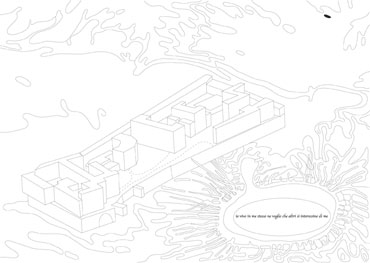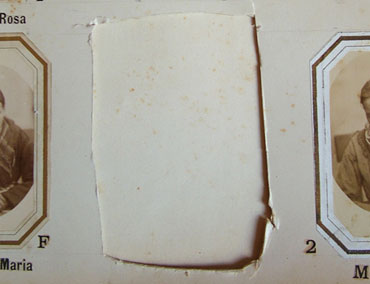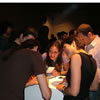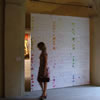l’isola dei folli Cerco Paul Noble su internet. Trovo le città. Sotto un articolo su una sua mostra, si parla di Waste Land. C’è un link a riguardo. Clicco. Ci sono degli estratti di Waste Land. Sono le stesse cose che ho sottolineato io. Un altro shock. Un altro rimando. Scarico le foto dei disegni di Noble. Prendo un libro sui ponti di Venezia, fotografo con la digitale le cose che mi interessano. Le scarico sul Mac, le ripulisco in Photoshop, le rinomino. Faccio una nuova cartella che chiamo S.SERVOLO, dentro metto tutte queste immagini. Una prima considerazione sulla follia, sarà banale, ma da qualche parte bisogna pur cominciare: il disagio psichico deriva dall’incapacità ad adeguarsi al reale. E’ innanzitutto un’ombra, una macchia nell’emotività dell’individuo. La malattia annulla le cronologie temporali. I sentimenti divengono abnormi, invasivi, ingestibili, sia le emozioni che le sensazioni fisiche. E’ uno strappo. I codici normali smettono di funzionare. Quello che dall’esterno potrebbe essere giudicato creativo lo è nella sua purezza, poiché non è mediato dall’intenzionalità dettata dalla cultura, ma arriva direttamente dall’inconscio che prende il sopravvento. Non è mai casuale, ma sistematico. Gli psicofarmaci agiscono sul cervello, immettono in esso le sostanze che non è in grado di produrre. Ho vissuto accanto a persone che non stavano bene, che erano incapaci di mettersi in un rapporto dialettico col mondo esterno e le sue dinamiche precostituite. Erano malate? Non credo, era solo disagio dell’esistere. E questo disagio lo vedo ogni giorno, lo incontro ad ogni passo. Siamo abituati a scegliere, a catalogare, separare, decidere, etichettare. Limitati da noi e/o dal resto. Siamo esseri finiti. Creiamo mitologie personali per rassicurarci, per crederci speciali, quando invece siamo solo carne che piano piano muore per dissolversi nella materia.Vorrei impazzire a volte per sottrarmi al tutto che continua a scegliere per me. Portare alle estreme conseguenze. Il primo lavoro che ho realizzato con il ricamo era la storia di una donna che improvvisamente, un mattino, si era svegliata e non era più stata in grado di riconoscere nulla. Le parole e gli oggetti non avevano più significato per lei. Il velo di Iside era stato sollevato, ma il trauma era stato insopportabile per la sua coscienza. L’ultimo tentativo che il suo corpo le aveva consentito era quello di ricamare di fronte ad una finestra. In una stanza bianca, tutta per se ovviamente. Lei continua a ricamare, la sua schiena si curva sempre di più, le sue dita piene di punture di ago, i fili sparsi a terra. Ma non serve a nulla. Il tessuto dell’esistere sfugge sempre un poco oltre, la vita rimane altrove. Ora lei è solo corpo, riflesso, funzioni fisiologiche. Respira, dorme, piscia, caga, ogni mese le vengono le mestruazioni, ogni giorno la fanno mangiare, le spazzolano i capelli, la portano a passeggiare in giardino. Lei vede gli alberi, i fiori, il sentiero di ghiaia, il sole, gli uccelli, ma non li guarda. Subisce il loro esistere passivamente. Il suo corpo sa solo infilare un filo in un ago e trapassare la stoffa, punto dopo punto. E’ l’unica cosa che ricorda, che sa fare. Ora e fino alla consunzione. Non sappiamo niente di lei. Chi era prima? Cosa desiderava? E non sappiamo se ora sta vivendo o no. In realtà lei potrebbe aver trovato la risposta, ma siamo nell’impossibilità di leggerla. |
the island of the fools I’m searching for Paul Noble on the Internet. I find the cities. The Waste Land is mentioned, under an article about an exhibition. There’s a link. I click on it. It has passages from the waste land. They’re same ones that I had underlined. Another shock. Another reference. I download the image of the Noble drawings. I get a book on the bridges of Venice, use my digital camera to take pictures of the things that interest me. I download them onto the Mac, clean them up with Photoshop, and rename them. I create a new folder that I call S.Servolo, putting all these images inside it. A first take on madness, it may be banal, but you have to start somewhere: psychological malaise comes from the inability to adapt oneself to the real. In the first place, it’s a shadow, a dark spot on the emotional life of the individual. Illness cancels out temporal chronology. Feelings, both emotions and physical sensation, become abnormal, invasive, unmanageable. It’s a laceration. Normal codes stop working. What might be judged creative from the outside is so in its purity, because it isn’t mediated by the intentionality dictated by culture, arriving, rather, directly from the unconscious which gets the upper hand. It is never random, but rather, systematic. Psycho pharmaceuticals act on the brain, emitting substances into it that the brain is incapable of producing. I have lived alongside people that were not well, that were incapable of establishing a dialectical relationship with the external world and its preconstituted dynamics. Were they ill? I don’t’ believe so. They were simply ill at ease with existence. And I see this uneasiness every day, I encounter it at every corner. We’re use to choosing, cataloguing, separating, deciding, labeling. Limited by ourselves and-or all the rest. We are finite beings. We create personal mythologies to reassure ourselves, to allow us to believe we are special, when we’re actually only flesh, dying little by little to dissolve into matter. I wish I could go crazy at times to remove myself from everything that keeps choosing for me. Bring things to extreme consequences. The first work that I created with embroidery was the story of a woman who suddenly, one morning, woke up and was no longer able to recognize anything. Words and objects no longer had any meaning for her. The veil of Isis had been lifted away, but the trauma to her consciousness was unbearable. The last attempts that her body allowed her was to embroider in front of a window. In a white room, of her own, obviously. She continues to embroider, her spine begins to curve, more and more, her fingers covered in needle pricks, the threads scattered on the ground. But it’s no use. The fabric of existence is continuously slipping slightly further away, life remains elsewhere. Now she is nothing but body, reflexes, physiological functions. She breathes, sleeps, pisses, shit, every month her period comes, every day they make her eat, they brush her hair, they take her for a walk in the garden. She sees the trees, the flowers, the gravel path, the sun, the birds, but she doesn’t look at them. She submits to their being, passively. Her body only knows how to thread a needle and pierce the fabric, stitch after stitch. It’s the only thing she remembers, that she knows how to do. Now, and until the moment she is consumed. We know nothing about her. Who was she before? What did she desire? And we don’t know if she is living now or not. In reality, she might have found the answer, but we are incapable of deciphering. Tomorrow I’m leaving for the Island of Fools. I imagine the lagoon crossing to be like the Bosch painting. The insane really were boarded onto ship, to keep them away from the city, but when the ships berthed at a port, they were made to re-embark once again, on a continuous quest, from city to city, until there were fewer and fewer and they gradually disappeared. Some of them drowned from loosing their footing, some wandered from the shore to set off down a path into the forest, where they were lost forever in its reaches. We will never know exactly what their fate was, because whatever happens unseen by other ceases to exist. Our existence is legitimized and takes form only under a gaze that does not belong to us. Today I was speaking to a friend on the phone and we started making wild conjectures about the island. We laughed together about the fact that it could go like in ten little indians. A group of artist gets invited to a venetian island under the pretext of creating a work on madness. Then the weather gets bad, the lagoon is unnavigable, the waterbus is unable to dock. The telephone lines go dead, there’s no cell phone coverage. And the artists start disappearing, without a trace. Or, true to script, since there’s a monastery on the island, some ancient demonic curse might be lurking somewhere in the archives just waiting to be read so as to spring back into action. Or twins could appear in the hallways of the asylum, inviting us to play, maybe with a couple of heads each. My friend and I go through all the horror films that come to our minds and whose titles we can’t remember. Closed doors, presences manifesting, blue flames running through the park, ancient acts of violence that can never be laid to rest, incomprehensible voices whispering their words in the primeval language before Babel. Stratifications of time, places, realities that intersect on the time plane that I traverse. Infinite perceptions, broken up thoughts, I’m overwhelmed by that claustrophobic feeling of needing to say a million things but not being able to express even one of them. My writing is hesitant, the Word screen appears too vast and white to me. I’m running out of words, I tap my nails on my mac keyboard. It’s cold and hot in this place where I’m writing now. The monks were famous for their medicinal arts. They cultivated plants on the island to make their curatives. It’s nighttime and I roam about the garden looking for the fig tree that Irene told me about. I walk across the lawn, damp with clover, observe the oleanders and the pomegranate trees, still unripe. I find the tree and pick a handful of its bright green fruits. I eat a few of them, and put the rest of them in the shared refrigerator standing at the entrance to the bedrooms. I place them next to the blackening bananas taken from the cafeteria, next to the bottles of Sicilian wines. What is the secret of this island? And then, is there really a secret? I’m looking for a story and I still don’t know if I’ll find it by reading the medical records. Everything around me is so beautiful that it’s almost an effort to distance myself from the fascination of looking. Water all around me, the horizon is hazy, the other island look as if they’re suspended in the air and waiting. They’re the ones who are looking at me, mutely. There’s too much silence. On Murano, in a glass factory shop, we start rummaging the rejects. I collect a dozen spheres that are cracked and deformed. Kristine, instead, chooses some thin glass rods. I’ve been carrying a little polyp made of Chinese glass in my purse since March, bought at Paolo Sarpi in Milan, a terrible imitation of the little Venetian animals. The madmen abandoned the island. Vanished, the only things they’ve left behind are what the gaze of others has recorded. Registers, record, photographs, measurements. Malaise in ordered list. Reading their medical record strikes me, in any case, as a new act of violence, it’s another violation of their intimacy. And yet it is the only way to bring them to life again, to document their existence. Tomorrow a museum will rise on this island, a tool for analyzing what came before us. A way of rehabilitating their lives? All I perceive is the silence that stretches out over the archipelago that surrounds me. The only way to tell this story lies in that subtle gap between what is said and what is impossible to say. Or in the mist of this city, which turns the buildings that rise out of the water into ghosts. Or in the blinding sun of its summers, overexposing images to the point of turning them white. |
l'isola dei folli
Progetto per "Art/Lab, laboratori di produzione artistica" residenza nell’ Isola di San Servolo, Venezia. A cura di Irene Calderoni.
|
left page, the island of the fools, transparent stickers cut on transparent plexiglas, 120 x 170cm for 1cm, 2005. Project for "Art/Lab" residency at the former asylum on San Servolo Island, Venice. Cureted by Irene Calderoni.
|







